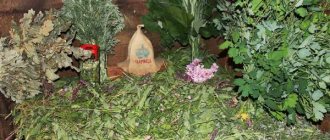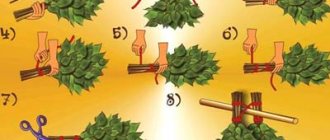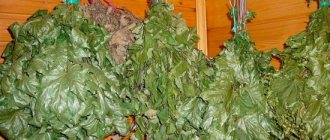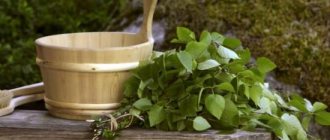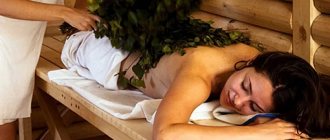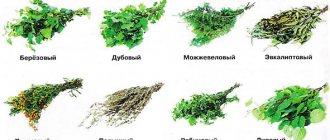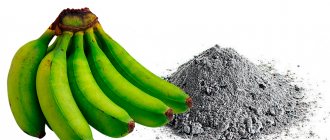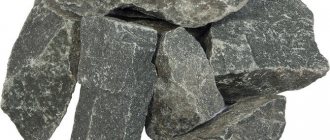Photo from the site Tyatya.ru Bathing in a bathhouse is the oldest tradition of our people, which dates back more than one century. Every second Russian has experienced this pleasure at least once in his life - to take a steam bath in a calm environment, to relax his soul and body. In this article we will talk about what types of Russian bath brooms there are, describe their types, shapes and varieties, healing properties and features, and also teach you which accessory is best to choose for you. We hope that our article will be useful to you.
What you need to know about bath brooms?
In many ways, the effectiveness of the treatment course depends on the type of broom, the correct time for cutting branches and other points.
In order not to make a mistake in choosing, you need to know:
- What types are there ? Depending on the type, the healing properties of the broom differ, including the effect on the human body.
- Procurement time . Each species has its own harvesting period; cutting branches at other times significantly reduces its beneficial properties or minimizes the effectiveness of its use.
- Rules for knitting a broom . If these are not followed, the process of using a broom will be more like torture than a massage.
- Steaming and storage . Here, too, there are certain features, the observance of which is mandatory (for more details: “How to properly steam brooms for a bath - rules for different types of branches”). Otherwise, either the “tool” itself will be damaged or its healing properties will suffer.
Nettle
Nettle broom is a good remedy for the treatment of radiculitis, rheumatism, and gout. If after physical activity you feel aches and pain in your joints, muscles and lower back, you should whip them with hot greens. The effect of nettle broom is associated with a powerful irritating, distracting and anti-inflammatory effect. With its regular use, blood pressure decreases, nervous tension is relieved, and blood circulation improves. Nettle also helps with furunculosis and acne. After such a broom, a slight pleasant tingling sensation is felt, and the skin acquires a healthy color.
Types of brooms: features and benefits
Extracts from plants are used as a basis in modern medicinal products, but during processing some of the beneficial properties are lost. In a Russian bathhouse, a broom is a kind of supplier of all useful substances and vitamins to the human body, since its production does not involve any processing, which ensures that all properties are fully preserved.
It is important to know before starting massage procedures what “cocktail composition” is needed. The choice is made based on the goal: prevention, treatment. In the latter case, the type of disease is taken into account.
Branches of trees, shrubs, grass and their combinations are used as starting material.
Let's look at what kind of bath brooms there are depending on the main component:
- birch;
- oak;
- lime;
- eucalyptus;
- nettle;
- coniferous;
- rowan;
- bamboo.
Birch
Birch contains not only essential oils and tannins, but also vitamin C, provitamin A, and flavonoids. This composition provides a complex effect on the body in several directions at once: it eliminates cramps, has a diuretic, choleretic, and expectorant effect.
The features of birch brooms are their excellent flexibility, the ability of porous leaves to absorb moisture (sweat), the absence of slipping on the body due to the rough surface of the leaves (pro
Crushed herbal powder
In the bath you can use herbs crushed to a powdery state. The herbal powder should be applied in a thick layer only to the steamed body. Steam expands the pores of the skin, and this facilitates the penetration of substances released from the powder. Then you can steam with a broom, compacting and as if pressing the plant parts into the body. After this you should rinse well.
This procedure promotes the healing of wounds and ulcers, cleanses skin pores, eliminates fatigue and drowsiness.
The herbs of wormwood, sage and St. John's wort, mint leaves, and linden flowers are suitable for bath powder.
Rules and nuances of making bath brooms
After you have studied the types of bath brooms and made a choice in favor of a specific option, you should not rush and immediately try to make it yourself. There are rules that must be followed. Any error can lead to the fact that the healing properties of the broom will be reduced, or difficulties will arise with its operation and other undesirable consequences.
Methods for making brooms were developed hundreds of years ago, but their effectiveness has been proven more than once, so to this day they have undergone only minor changes regarding some small details.
The production of this miracle massager involves several stages:
- Choosing a tree . What is taken into account here is not so much the type itself as the appearance, growing environment and other factors that influence the medicinal properties of the finished product.
- Procurement time . Each tree species or plant species has its own collection period - the time when their beneficial characteristics are fully manifested. Drying blanks also involves a certain technique that allows you to preserve all the properties.
- Knitting a broom . The ease of use of the bath item will depend on the correctness of this work. The result should be a traditionally shaped broom respecting the proportions of a “fan” and a “holder”, and not a bouquet of branches, much less a broom.
For beginners, it is recommended that you first master all these processes for making a broom from one material; later, once you acquire the appropriate skills, you can experiment with combinations of several components.
Method number 3. Optimal
This method is used by most steamers and considers it the most optimal. First, the broom is dipped in warm and then in hot water (for about 20 minutes). After this, the bundle is shaken off and wrapped in a plastic bag.
Before starting the bath procedures, take the broom out of the bag, rinse it again, steam it over hot stones for 30 seconds and begin the procedures.
Harvesting periods for each type of broom
It doesn’t hurt to know when to cut brooms for a bath and how to do it correctly. First of all, a responsible approach requires choosing the area where the components of the bath broom will be collected. A suitable location is considered to be one that is located at a considerable distance from industrial facilities, highways and residential complexes. It makes no sense to use a broom if the main material was collected in another area, since its benefits are questionable, but the harm is quite real. If such a place is found, you should wait for the right time to collect.
Procurement times may vary depending on the base material:
- Birch . Traditionally prepared during the celebration of the Trinity, if the weather is pleasant with sunny days. A slight shift in the date is possible in cloudy and rainy weather. A more specific period when birch bath brooms are harvested is at the end of the first month of summer and until the beginning of July.
- Oak _ You can safely start harvesting from June, and since the leaves of this tree are very durable, the collection period has been extended until September. It is popularly believed that burdock growing at the roots of an oak tree indicates the beneficial properties of the tree.
- Linden . The most suitable time for collection is the beginning of linden flowering in early spring. This tree perfectly absorbs all industrial waste and dirt, so those growing within the city cannot be used for collection.
- Eucalyptus . More suitable are those species that have an external resemblance to a weeping willow. At the end of summer you can start harvesting until the beginning of September.
- Nettle . It is recommended to cut off shoots in the middle of the plant. The most suitable time is when nettles bloom, when they give off a characteristic tart aroma.
- Needles . Fir and juniper can be harvested at any time of the year (read: “How to steam a fir broom for a bath - tips for use”).
- Bamboo . It is brought to us in finished form from Asian countries, where it is prepared in winter.
- Rowan . Preference should be given to branches located in the middle of the bush or tree crown. The beginning of summer is the best time.
As for the time of day, morning is considered ideal for preparing bath brooms. But you should not cut the shoots at dawn, there should no longer be dew on them.
Method number 2. The fastest
For those who are in a hurry to whip themselves and others with a broom in the steam room, there is the simplest and very fast way to do this. Simply dip the tool in hot water for a few minutes, then take it out and get to work.
Of course, experienced bath attendants do not particularly welcome this approach, but it is used by many people who do not see bath procedures as a sacred ritual.
Drying and storing bath brooms
It is known that the healing properties of herbs and plants are lost if they are improperly dried and stored. This also applies to freshly cut branches for bath brooms. Violation of the rules of these processes causes the low efficiency of using such massagers. So, the shoots or branches are dried in a dry place, protected from direct sunlight. Before they go into storage, they must be tied to a rope and left under a load for a day.
How should you store a bath broom that has never been used? Since bath items are usually prepared in large quantities, they are packaged in twos and hung on a rope in a dark and ventilated place. However, as experience shows, this method has a disadvantage: over time, the fan becomes deformed, taking on the appearance of a broom.
To solve this problem, a new storage method was developed: the branches are stacked in a sheaf and covered with ordinary hay. In this case, the broom is tied before using it. Compliance with these simple rules allows you to preserve all the beneficial properties of the natural material and provide the expected healing effect to bath procedures.
Method number 1. Half an hour
So, let's move directly to the steaming methods. The first method is used some time before bath procedures.
First, you need to dip the broom into a bucket of heated water and leave it there for 25 minutes. After this time, add hot water to the container, cover it with something and wait no more than ten minutes.
Then you can take out the steamed broom, shake off excess water and begin the procedures.
Technique for knitting bath brooms
There are several important features that should be taken into account when knitting a bath broom:
- The location of the branches is considered correct if thick branches are located in the center of the bundle, and thin branches surround the “frame” on all sides. Thus, a regular fan is formed. The “holder” is adjusted using ordinary garden shears.
- To avoid problems with the quality of operation of the broom, you need to take care of the convenience of the “handle”. This part should be cleared of leaves and twigs. Its thickness also plays a role: the recommended diameter is 3 centimeters. Also, to avoid injury, you should wrap a cloth around the area that will come into contact with your hand during operation.
You can increase the strength of the broom by securely fixing the branches in two places: the broom is tied with twine at the fan, and with a strip of fabric - in the place where the handle ends.
Method number 5. Standard
This method is used several hours before visiting the steam room. The broom should be immersed in a previously prepared container with warm water and left for half an hour. At this time, it must be turned over periodically so that the leaves can be saturated with moisture.
After this, the bundle must be removed and immersed again in the container with the handle down. So you need to keep it in the water for another ten minutes, and then boldly go to the steam room.
Chamomile
Chamomile contains a unique blue biological substance - chamazulene. It is an excellent antiseptic and antispasmodic with a sedative effect. It is used in the treatment of skin diseases, ulcers, poorly healing wounds, sunburn, and has proven effective against psoriasis and neurodermatitis. Chamomile brooms are used for painful critical days and headaches; they can be used as a sedative even for children, especially with increased tearfulness. The aroma of such a broom acts as a strong, stress-relieving remedy, especially for young parents whose children sleep poorly at night. Chamomile broom can be used for various forms of nervousness, irritability, insomnia; it is also suitable for women with menopausal disorders of the nervous system. Chamomile brooms are widely used in skin care. It is ideal for treating burns, cuts, wounds, ulcers and skin inflammation. A steamed broom is used to massage the head so that the hair becomes stronger and does not fall out. Previously, chamomile was combined in brooms with meadow geranium and lavender to attract individuals of the opposite sex. This broom works equally on both men and women.
Tansy
Tansy brooms have diaphoretic, anti-inflammatory, antimicrobial, antifever properties and are used for nervous disorders, headaches, migraines, epilepsy, inflammation of the kidneys and bladder, kidney stones, rheumatism, gout, pulmonary tuberculosis, colds, delayed menstruation, dislocations, wounds and furunculosis. Tansy brooms with the addition of rowan leaves enhance the processes of stimulation of the nervous system, eliminate the relaxing effects of the bath procedure, and prepare the body well for work. It is good to steam with such a broom in the morning to feel cheerful and in a good mood all day long.
Sage
The fresh and spicy smell of sage attracts Russian people. In the old days, it was noticed that sage brooms give a person remarkable strength, health and long life. Sage is used in baths of a love nature; it has a particularly beneficial effect on the female body. This effect is caused by an estrogen-like substance contained in sage. Sage brooms were used for married couples where love was cooling off. After steaming in such a bath, the spouses regained tenderness for each other. And the steamed sage was brought home and spread under the bed or placed at the head like a bouquet. A sage broom perfectly relieves stress, helps with creative work, opening the soul and stimulating imagination. Sage contains natural antibiotics, so inhaling its aroma helps with all diseases of the throat, mouth, larynx, inflammation of the gums, sore throat, bronchitis, and asthma. It is also used for skin care for pustular rashes.
Ledum
Ledum has bactericidal, anti-inflammatory, and expectorant effects. Ledum brooms are used for gout, arthritis, neuralgia, radiculitis and bruises as a pain reliever. Such brooms are good as a wound-healing, hemostatic agent, as well as for frostbite, diathesis and scrofula. Steaming with wild rosemary is recommended as a diaphoretic for colds, bronchitis, bronchial asthma, cough, pulmonary tuberculosis, as well as for angina pectoris and inflammation of the intestines. Massage with a wild rosemary broom helps to dilate venous vessels, lower blood pressure, improve blood circulation and promote good sleep.
